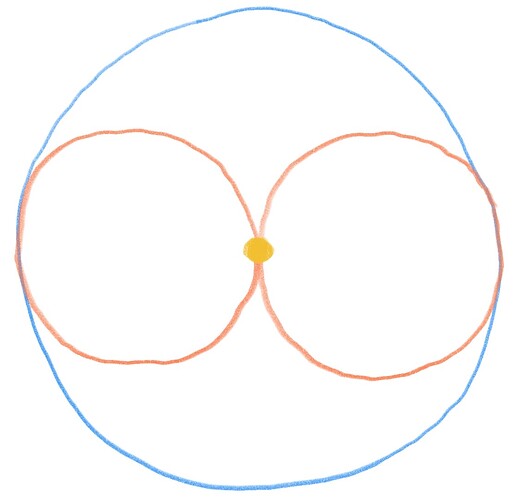That’s why so many of my reflector lights have diffusion film on 'em…
You were right in your previous post that on a sphere, same solid angles may subtend different areas. Very nice catch!
I think they would still free the same amount of light, but the same hole would represent different solid angles from the emitter.
If one believes that the total flux hitting an area equals the integral of flux density (lux) over area, then the proportion of an area over a level-intensity surface enclosing the emitter must equal the proportion of total flux hitting that area.
In any case, I realized that there exists a point of confusion, namely, that 2D actually serves as a very misleading analog of 3D for this discussion, with the fundamental reason being that in 2D, light follows a first-power inverse decay law, not the inverse square law. An interesting consequence is that in 2D, a half-uniform emitter has a level-intensity sphere in front of it, not the Lambertian! To see this, recall the derivation here. In 2D with half-uniform emitter, we lose a 2r/L term from the weaker decay law, and also lose a cos(theta) term from changing Lambertian to uniform; the net product is not changed. Consequently, in 2D, the blue and orange curves below are both level-intensity curves for the yellow uniform emitter!
What rabbit hole :-p it might be deep, but it’s not lonely down here! BTW, it’s awesome that you could make animations.
Unfortunately, the natural generalization that equal solid angles subtend the same area fails to be true, my mistake. Fortunately, this reconciles some contradictions and now should not conflict with the idea that same areas on a level-intensity surface contain the same total amount of light.
I think the “ mold/design ” cost may be the key, as I know the customization cost for a small TIR is between 5000-13000 USD, while the reflector is under 100USD. Of course, there are many existing TIR models on the market, but adaptation may still be a problem. And referring from M21F and IF22A, the “throwing efficiency” of the reflector seems to be higher.
In fact, I don’t know if you’ve noticed, but pocket throwers tend to come in a very wide variety of sizes, with 30-45mm being the norm. But TIR pocket throwers tend to be just 40mm, which is most likely because they happened to choose the same lens on the market due to cost.
“Technically” TIR can do everything, while in reality reflectors tend to be preferred due to cost constraints.
The use of reflectors for mid-large throwers (e.g. Acebeam p20) I think is an absolute fault as they are primarily designed for use at a distance, but the spill will still shine too much light close up, yet not good enough for close up path lighting use.
It depends on the use case, but I agree that sometimes “useful spill” can become “annoying spill”.
